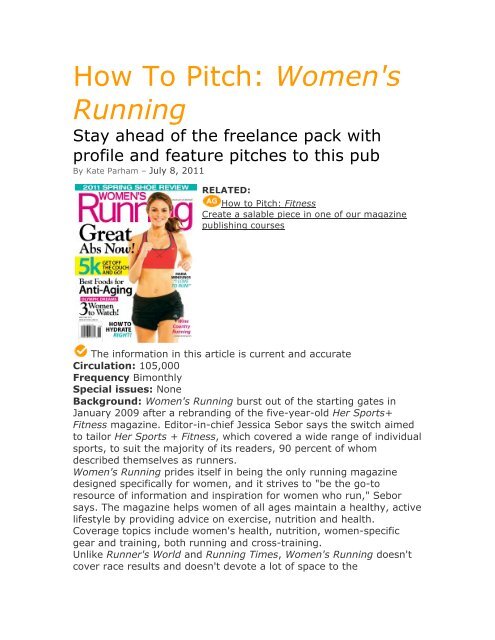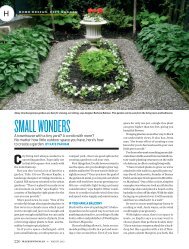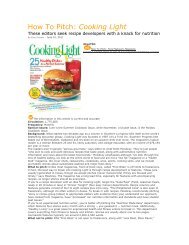How To Pitch: Women's Running - Kate Parham
How To Pitch: Women's Running - Kate Parham
How To Pitch: Women's Running - Kate Parham
You also want an ePaper? Increase the reach of your titles
YUMPU automatically turns print PDFs into web optimized ePapers that Google loves.
<strong>How</strong> <strong>To</strong> <strong>Pitch</strong>: <strong>Women's</strong><br />
<strong>Running</strong><br />
Stay ahead of the freelance pack with<br />
profile and feature pitches to this pub<br />
By <strong>Kate</strong> <strong>Parham</strong> – July 8, 2011<br />
RELATED:<br />
<strong>How</strong> to <strong>Pitch</strong>: Fitness<br />
Create a salable piece in one of our magazine<br />
publishing courses<br />
The information in this article is current and accurate<br />
Circulation: 105,000<br />
Frequency Bimonthly<br />
Special issues: None<br />
Background: <strong>Women's</strong> <strong>Running</strong> burst out of the starting gates in<br />
January 2009 after a rebranding of the five-year-old Her Sports+<br />
Fitness magazine. Editor-in-chief Jessica Sebor says the switch aimed<br />
to tailor Her Sports + Fitness, which covered a wide range of individual<br />
sports, to suit the majority of its readers, 90 percent of whom<br />
described themselves as runners.<br />
<strong>Women's</strong> <strong>Running</strong> prides itself in being the only running magazine<br />
designed specifically for women, and it strives to "be the go-to<br />
resource of information and inspiration for women who run," Sebor<br />
says. The magazine helps women of all ages maintain a healthy, active<br />
lifestyle by providing advice on exercise, nutrition and health.<br />
Coverage topics include women's health, nutrition, women-specific<br />
gear and training, both running and cross-training.<br />
Unlike Runner's World and <strong>Running</strong> Times, <strong>Women's</strong> <strong>Running</strong> doesn't<br />
cover race results and doesn't devote a lot of space to the
performance of elite athletes. Coverage of elites is limited to profiles of<br />
those with inspirational stories. Instead, the mag is community<br />
focused, highlighting real women so that readers can gain inspiration<br />
from their peers, Sebor says. One way the magazine does this is<br />
through their half marathon series, which is currently in three states<br />
(Tennessee, Arizona and Florida) and expanding rapidly. "It's a race<br />
series tailored specifically for women, so that we can have fun and feel<br />
confident, celebrated and comfortable," says Sebor.<br />
What to pitch: <strong>Women's</strong> <strong>Running</strong> relies on freelancers for 60 to 75<br />
percent of its content with roughly a quarter of that work stemming<br />
from queries. Sebor says editors are especially interested in pitches on<br />
the following topics: new women-specific running gear, relevant news<br />
about women's health or running, studies related to runners and<br />
nutrition, ideas for profile subjects, and new books and websites that<br />
cover women's health or running.<br />
Most nutrition stories are written by registered dieticians and other<br />
experts with nutrition degrees, while most training features are<br />
generally written by running coaches. Don't worry if you don't fit the<br />
bill -- there's plenty of space for other freelance features. <strong>Women's</strong><br />
<strong>Running</strong> wants inspirational or motivational profiles of professional or<br />
amateur runners who have accomplished interesting things in the<br />
sport and who serve as role models in everyday life; these profiles run<br />
roughly 1,500 words.<br />
"Fuel Your Run" stories average 1,200 words and focus on nutritional<br />
information to support fitness activities. Health stories, which run in<br />
the "Live Healthy" section, are 1,000-words pieces citing numerous<br />
experts on topics relevant to active women.<br />
Fitness stories run 800 to 1,000 words, and provide workouts that<br />
include eight to 10 exercises designed to help runners build strength<br />
or cross-train. Previous topics have included yoga for runners, building<br />
core strength and circuit training. These stories are typically written by<br />
freelancers with a personal training background and relevant<br />
certifications.<br />
"Beauty in Motion" stories average 800 to 1,000 words and can range<br />
from skin care to beauty tips for active women. "The articles are<br />
always written for the athletic woman and have a health angle, like<br />
caring for runners' feet," Sebor says. (<strong>Pitch</strong>es about cosmetics should<br />
be steered toward other publications.)<br />
"Active Getaways" are 1,200-word pieces detailing a multi-sport<br />
destination or destinations appropriate for active travel. These stories<br />
can be written in the first person.<br />
"Try This" features 1,000-word articles introducing runners to a new<br />
sport. It includes sidebars on gear, tips for beginners, and places to try<br />
the sport. Previous topics have included mountain biking, triathlons
and snowshoeing.<br />
What not to pitch: Freelancers contribute to all sections of the<br />
magazine, except for the "Women Who Move" department. Avoid firstperson<br />
essays (with the exception of "Active Getaways" pitches),<br />
especially the dreaded "my first marathon" story. In addition, most of<br />
the one-pagers and columns are written by in-house staff or<br />
contributing editors.<br />
Online opportunities: None<br />
Percentage freelance-written content: 60-75 percent<br />
Percentage of freelance submissions accepted: About 10 percent<br />
Recent freelance stories pitched and published: Travel articles<br />
and "Active Getaways" are almost always written by freelancers. For<br />
examples, check out the Sonoma County running story in the<br />
May/June 2011 issue and the story on a Himalayan Run and Trek in<br />
Mar/Apr 2011. The upcoming profile on breast cancer survivors for<br />
Sep/Oct also started as a freelance pitch.<br />
Etiquette: Sebor prefers to receive letters of introduction with clips<br />
and a resume. "That's more important than queries, although those<br />
are definitely appreciated also if you have a great one that might get<br />
our attention," she explains.<br />
Lead time: Four months<br />
Pay rate: Pay varies by department and assignment, but averages<br />
roughly 50 cents per word.<br />
Payment schedule: Payment is issued on the first day of the issue's<br />
publication date. For example, if a feature runs in the May/June issue,<br />
a freelance writer will be paid on the first day of May.<br />
Kill fee: 50 percent<br />
Rights purchased: All, "but we are open to negotiations," says<br />
Sebor.<br />
Contact info:<br />
<strong>Women's</strong> <strong>Running</strong><br />
1499 Beach Drive SE, Suite B<br />
St. Petersburg, FL 33701<br />
Phone: (727) 565-1768<br />
Fax: (727) 824-0859<br />
www.womensrunningmag.com<br />
Direct all pitches to:<br />
Editor-in-chief Jessica Sebor: JESSICA at WOMENSRUNNING dot COM<br />
NEXT >> <strong>How</strong> to <strong>Pitch</strong>: Fitness<br />
<strong>Kate</strong> <strong>Parham</strong> is a Dallas-based freelance writer<br />
at www.<strong>Kate</strong><strong>Parham</strong>.com.




